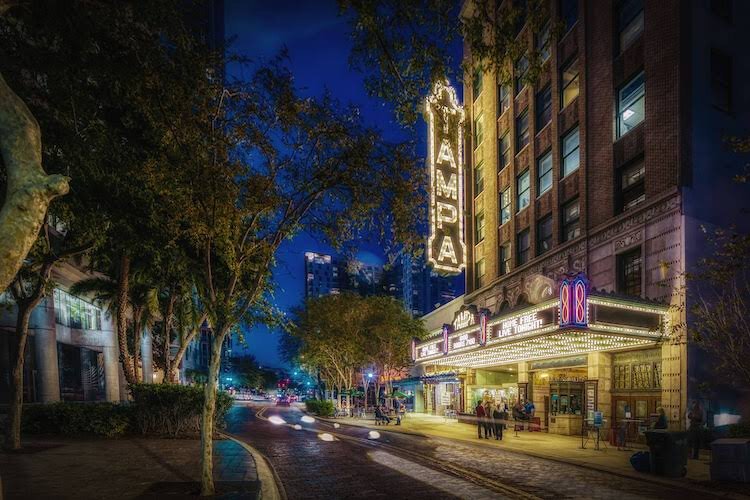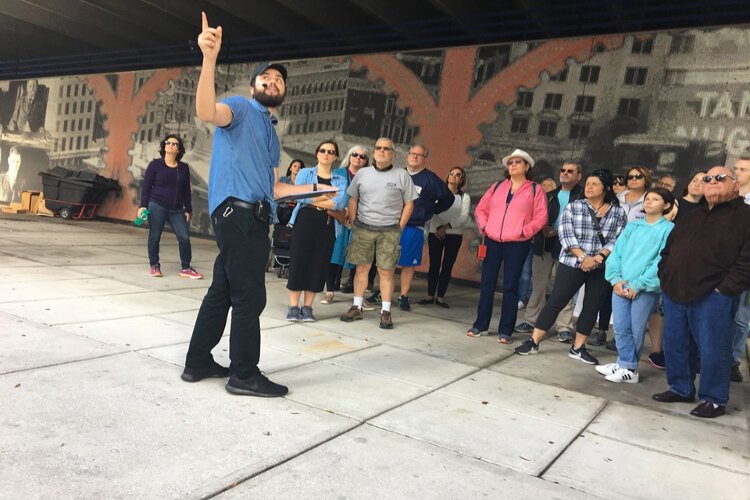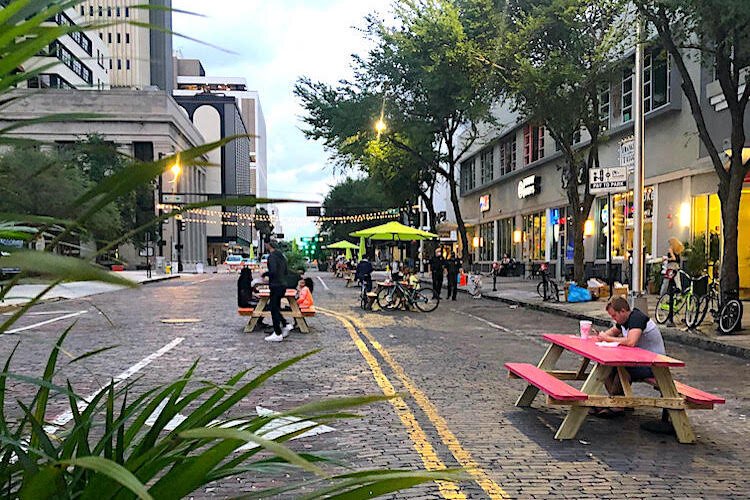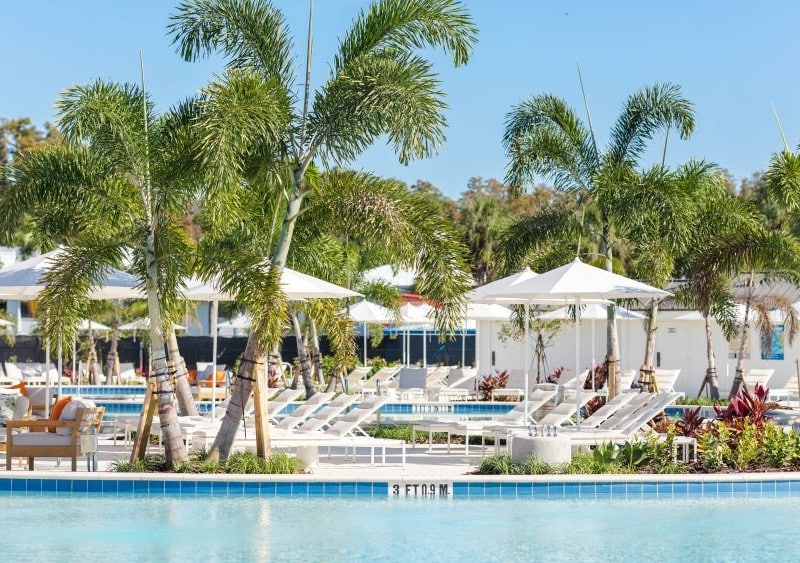In Tampa’s downtown core, rich history and a modern development boom
In Tampa's downtown core, the city's history meets a modern development boom.
T.J. Chaltry leads monthly walking tours of downtown Tampa’s core as a Tampa Bay History Center guide. During the 90-minute, one-mile walk, he talks about old City Hall, mentioning that the clock in the 1915 structure is named Hortense. He notes that the 19-story Floridan Hotel, built in 1926, was the tallest building in Florida until 1966. Elvis Presley stayed there in 1955.
He takes the tour along the “five and dime” store block to the old F.W. Woolworth’s, where in 1960 Black civil rights activists staged a protest sit-in at the segregated lunch counter. Tourgoers see the S.H. Kress building, with its elaborate Italian Renaissance Revival style facade.
“It was the center of commercial and social life on Franklin Street back in its heyday in the 1940s and 50s,’’ Chaltry says.
He tells them that the Tampa Theatre, built in 1926, was the first air-conditioned commercial building in the city.
And he also talks about the skyscraper boom that has characterized downtown since the turn of the 21st century but started in the 1980s. He says the 42-story Bank of America Plaza, built in 1986, was the tallest in town.
“And then (in 1992) 100 North Tampa was built deliberately just two feet taller than Bank of America Plaza,’’ he says.
Downtown’s transformation
It’s been quite a transformation.
Downtown Tampa used to be alive only in the daytime. At 5 o’clock, downtown workers drove home to the suburbs. One of the few places open at night was the legendary bar The Hub, which is still in business though not in its original location.
Now, the street parking fees are $2.50 an hour and don’t end till midnight. As happened in the Channel District to the east, apartment towers are popping up everywhere. The Skypoint, 33 floors, was built in 2007; The Element, 34 stories, in 2009; Nine15, with 23 stories, in 2016; and The Henry, 23 stories, opened in 2021; Like in the Channel District, many of the tenants of these buildings came from other parts of the country, still have their jobs and work remotely, and make high salaries. Rents for a one-bedroom apartment are more than $2,000 a month.
A restaurant or bar occupies just about every corner in the downtown core. They include Tampa Pizza at Tampa and Zack Streets; Kafee and Kabob at Tampa and Polk; Butter’s Burgers at Ashley and Zack; Eddie and Sam’s N.Y. Pizza at Tampa and Zack. Taps Restaurant Bar & Lounge at Ashley and Polk; the Paddy Wagon Irish Pub at Tampa and Cass; C.W.’s Gin Joint at Franklin and Twiggs; and The Hub at Franklin and Polk.
Other offerings include Bizou Brasserie, a high-end restaurant inside Le Meridien hotel, which occupies the former federal courthouse on Florida Avenue, built in 1905. Ulele is on the Hillsborough River just north of the Straz Center for the Performing Arts. Columbia Cafe is in the Tampa Bay History Center. Bavaro’s Pizza Napoletana & Pastaria is on Franklin Street; Spain Restaurant is on N. Tampa Street and Hattricks is on South Franklin; Malios is in Rivergate Tower on Ashley; and Maestro’s is at the Straz Center.
Stephanie Ferrell has lived downtown since 2005.
“I’m a pioneer,’’ she says with a laugh.
Ferrell, a well-known architect who specializes in restoring and refurbishing historic buildings, owns a condo at the Art Center Lofts, a five-story, 42-unit building on Doyle Carlton Drive and Laurel Street.
“I did think that things would materialize, that there would be positive change in this area,” she says. “Living on the Hillsborough River was definitely attractive to me – and living near the Straz.’’
She likes being within walking distance of both the Straz and the restaurant Ulele. She served as a consultant to the Gonzmart family’s Columbia Restaurant Group when the company transformed an old city waterworks building and pumping station into the popular dining spot.

Ed Arismendis, owner of Reina Shoe Repair on Twiggs Street, is enjoying the resurgence. The building has been a shoe store and in the same spot since 1928; Arismendis has owned it since 2002.
“When I came here, it was like a ghost town,’’ he says.
But he says his business is up 70 percent over the old days now that downtown has become a popular spot to live.
“I’ve got people here, they come in every day from different parts of the United States. They love Tampa,’’ he says.
Chaltry, who arrived in 2002 as a middle school student, says it has been fun to see the transformation of downtown.
“I give a lot of credit to the city for realizing that water is a feature,’’ he says. “They have brought people to the waterfront through placing attractions along the Riverwalk, and making the Riverwalk itself, which was an achievement and key, really. And now there are talks of extending it well beyond downtown and through Tampa Heights.’’
The roots of the revival
Sandra Freedman, who served as Tampa mayor from 1986 to 1995, gives credit to the arrival of three main venues for downtown’s awakening: The Straz Center in 1987, the Tampa Convention Center in 1990, and the Florida Aquarium in the Channel District in 1995.
One dealt with arts and nightlife, she says. The convention center increased tourism, plus local events could be held there. And the aquarium was entertainment for the whole family. Had they been three office buildings, she says, it wouldn’t have sparked the change.
The arrival of the Tampa Bay Lightning and the Amalie Arena do “incredible things for downtown,’’ she notes. “All of the pieces just started to fall into place. But I think those three projects were really the catalyst.’’
Freedman was on the Tampa City Council in the late 1970s and early 1980s when what was called the Quad Block was built on Franklin Street, the first street in old Tampa to be paved and have sidewalks. The Quad Block turned five blocks of South Franklin Street into a pedestrian promenade and built the Fort Brooke parking garage, the Hyatt Hotel (now Hilton) and One City Center, which opened in 1981 as the city’s second skyscraper, after nearby Park Tower.
“It had an impact at the time because you had a building that you could put people in and that created a need for restaurants and that kind of stuff,’’ Freedman says.
And getting a high-end hotel “was a big deal for Tampa in those days.’’ But she says it didn’t spur housing.
Preserving history
Skyscraper residences are sprouting now, so much so that the Tampa Downtown Partnership is on a campaign to keep as much of the historic downtown intact as possible.
With help from the Hillsborough County Historic Preservation Challenge Grant Program, the Partnership commissioned the Franklin Street Corridor Historic Preservation Plan to celebrate the history and identify historic structures along Franklin Street and connecting streets and develop a strategy and action plan to save them.

“We started with a vision plan for Franklin Street, and we heard overwhelmingly from the stakeholders that one of the things they valued most is the historic character,’’ says Karen Kress, senior director of transportation and planning for the Tampa Downtown Partnership.
The plan tallied 171 buildings, including 115 structures that are eligible for historic status (once they turn 50). A number of buildings on Franklin Street north of Interstate 275 are in that category and comprise the “Upper North Franklin St. Historic District.” Among them, the Arlington Hotel, built around 1913 and occupied for many years by Badcock Furniture Store; the Southern Furniture Exchange Building on North Florida Avenue, built in 1921; and the General Automobile Supply Building, built in 1915 on North Florida Avenue.
Kress says the Partnership intends to help organize a workshop in the fall and invite property owners, real estate and financial professionals to discuss preserving the historic properties and talk about the financial advantages. They also collaborated with the Tampa Bay History Center and owners of the preserved 220 Madison building to place large historic photographs on the windows of CVS to show what the area used to look like.
Ferrell, who was instrumental in getting north Franklin Street designated a historical district in 2010 and was the architect on the renovation of the former Arlington Hotel, says one big advantage is a substantial tax break for the owners who decide to restore their buildings.
“If the work is done according to historic preservation standards, they can apply for a 20 percent federal income tax credit,’’ she says.
South of the interstate, the Floridan is being restored and the owner of the Kress building has said that the facade will remain intact.
Tampa Theatre renovation
And the elaborate visual fantasy that is the Tampa Theatre is undergoing a major renovation, which marketing director Jill Witecki says should be complete by its 100th birthday in 2026. A 43-seat theater will be created in the storefront next door, which used to be a flower shop. The third floor of the main theater building will be refitted as a flexible space, Witecki says, noting that one advantage is it will give them more room when they hold their summer camp. Basement dressing rooms will be refurbished and the 97-year-old plumbing will be updated.

The main theater, designed to look like a Mediterranean courtyard, will have its walls and ceiling completely renovated. More energy-efficient lights will create the twinkling stars effect on the ceiling, and the machine that simulates clouds moving across the sky will be repaired.
The second theater will be “a game changer for us for how we do business,’’ Witecki says, noting that it will give the theater more flexibility in booking movies and live performances.
The renovations will cost an estimated $21 million. The Downtown Community Redevelopment Area board has contributed $14 million toward the project.
“That’s a huge springboard for us,’’ Witecki says.
The theater is also hoping to raise an additional $21 million for an endowment fund.
Kress says it’s important to save and use historic buildings like Tampa Theatre, the Floridan and the old federal courthouse because they lend character and authenticity to the city.
“This all goes back to making Tampa a place, not just anywhere, U.S.A.,’’ she says.
For more information, go to Franklin Street Corridor Historic Preservation Plan
and Tampa Bay History Center walking tours.
The Tampa Downtown Partnership and 83 Degrees Media have an underwriting agreement in place to profile the unique neighborhoods that make up Tampa’s downtown. For other stories and photo galleries in the series, go to:
Channel District’s evolution from industrial district to live, work, play urban lifestyle
Masthead gallery: Water Street Tampa
Masthead gallery: Tampa’s West River area.

















